If you’ve been paying attention to the car audio industry over the last two years, you know Sony has been steadily rolling out its new flagship-level Mobile ES equipment. I’ve already been blessed with the outstanding performance from the XAV-9500ES digital media receiver and the impressive XS-W104ES 10-inch subwoofer. Now it’s time to check out one of their new Mobile ES amplifiers. In this Test Drive Review, I take a close look at the features and performance of the XM-1ES mono car audio subwoofer amplifier.
Specifications and Design Features of the Sony Mobile ES XM-1ES
Sony rates the XM-1ES as capable of producing 600 watts of power when driving a 4-ohm load. That number jumps to 1,000 watts with a 2-ohm load. The signal-to-noise ratio is 77 dB, and the total harmonic distortion and noise (THD+N) is less than 0.05%.
From a physical design standpoint, the XM-1ES is based on a cast aluminum heatsink that measures 10.63 inches wide and 8.46 inches deep. The amp stands 2.36 inches tall, so it would be easy to fit under the seat of a car or truck. All the connections are made along the front edge of the amplifier, and a removable top panel conceals the configuration switches and potentiometers. Before we dive into the signal processing features and connections, it’s worth noting that Sony put significant effort into the chassis design for the Mobile ES amplifiers. The impressively thin 1.2-mm bottom plate is reinforced to add damping, so it doesn’t vibrate and rattle while underway or when playing music at high volume levels. A small speed-controlled cooling fan in the back left corner of the amp ensures that the system remains reliable and can crank out your favorite music on even the hottest days.
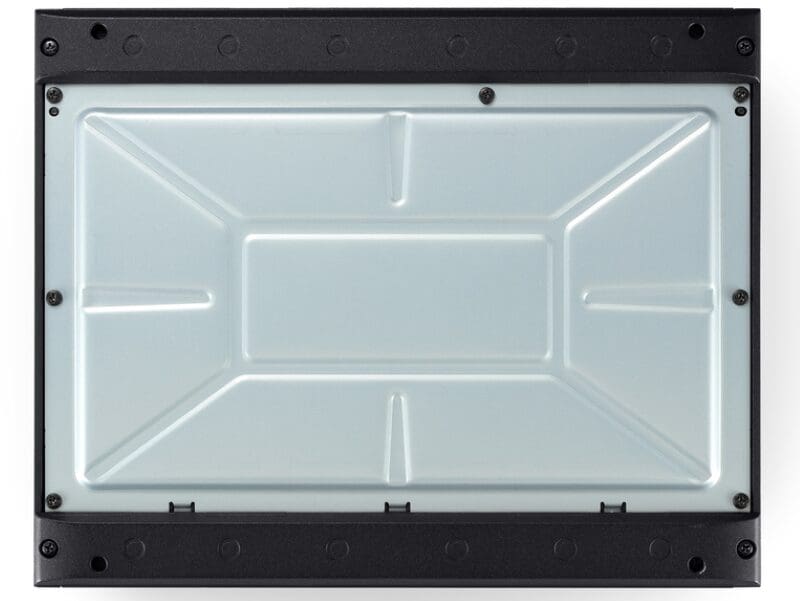
The front panel has custom-tooled terminal blocks for 0-AWG power and ground connections and the remote turn-on lead. A second block will accept two pairs of 8-AWG speaker cables. All the wires are secured with large-diameter hex-head set screws accessible from the top panel. To the left of the power input block are four ATC-style 25-amp fuses.
A phone-style jack for the included remote level control is on the far-left side of the end panel. Sony didn’t skimp here – they tooled up a beautifully sized knob for the remote. I know it’s a small thing, but it looks great – like it belongs in a vehicle. A switch beside the remote input jack lets you select between high and low RCA input ranges. The amp can accept up to 16 volts on the RCA inputs in the high range. In the low range, the maximum voltage is a still-impressive 8 volts. There are two sets of RCA jacks as the remaining features on this panel. One pair is for the inputs, and a second is available as outputs to drive another amplifier.

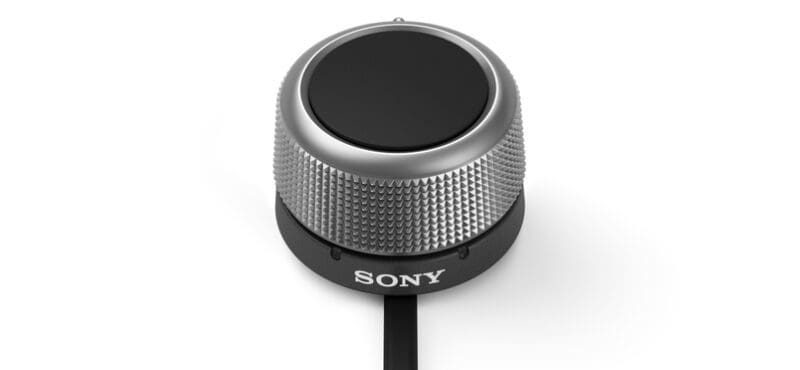
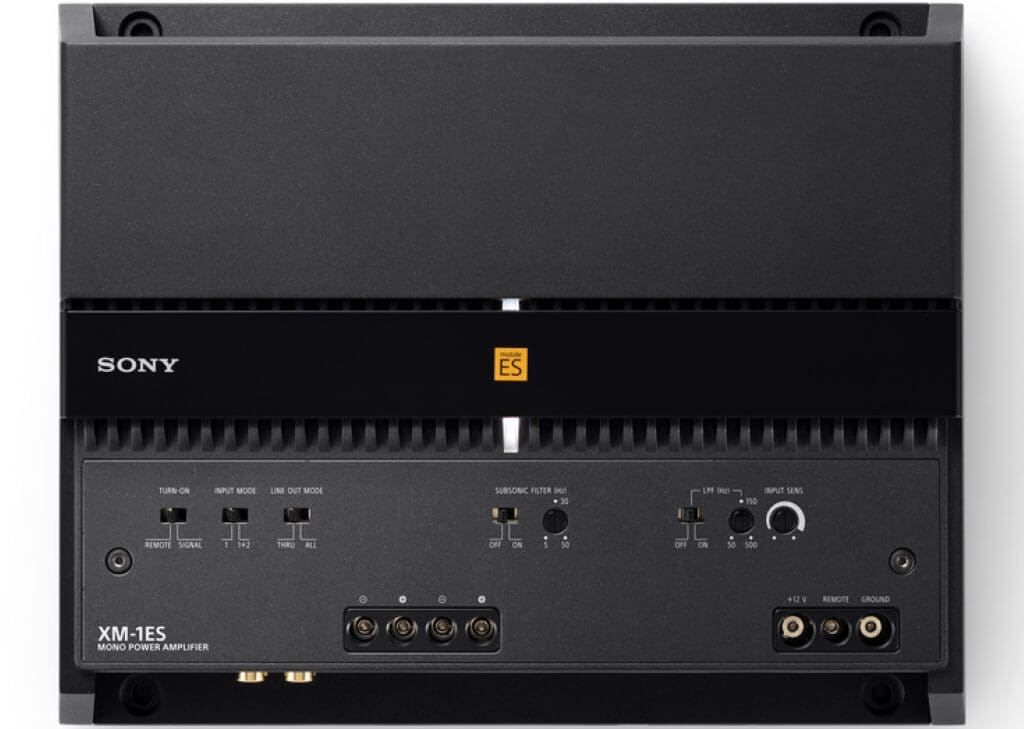
Under the top cover, we find an extensive array of system configuration and control switches. Starting from the left, the Turn-On switch sets the amp to activate with a +12V connection to the remote terminal or automatically by detecting an audio signal on the RCA jacks when in High level mode. The next switch handles some simple signal routing. Many source units have a single RCA jack for the subwoofer output. Your installer can connect that single cable to input 1, then set this switch to position 1. Alternatively, if your radio has a pair of RCA outputs for the subwoofers, they can both be connected to the amp, and the signals can be summed internally with the switch in the 1+2 mode. The Line Out switch controls what’s provided on the output RCA’s. In the Thru position, the signal from input 1 goes to output 1, and the signal from input 2 goes to output 2. In the All position, the input signals are summed together and go to both outputs.
The following section is the infrasonic filter control. The -24 dB/octave filter can be activated or bypassed with the provided switch, and the high-pass frequency can be set between 5 and 50 hertz, depending on the subwoofer enclosure design. Next is the low-pass crossover selection and adjustment. The low-pass filter can be adjusted from 50 to 500 Hz and has a -24 dB/octave slope. It’s nice that this amp has fourth-order filters, ensuring that signals will sum evenly at the selected crossover points. Amps with -12 dB/ and -18 dB/octave filtering require some underlap.
Last is the sensitivity control. In the low range, the amp can produce full power with signals between 200 millivolts and 8 volts, and in the high range, the limits are 3 and 16 volts. A white LED in the center of the amp, just below the Mobile ES logo, illuminates when the amp is active. The logo panel can be rotated 180 degrees to suit the design of your installation.
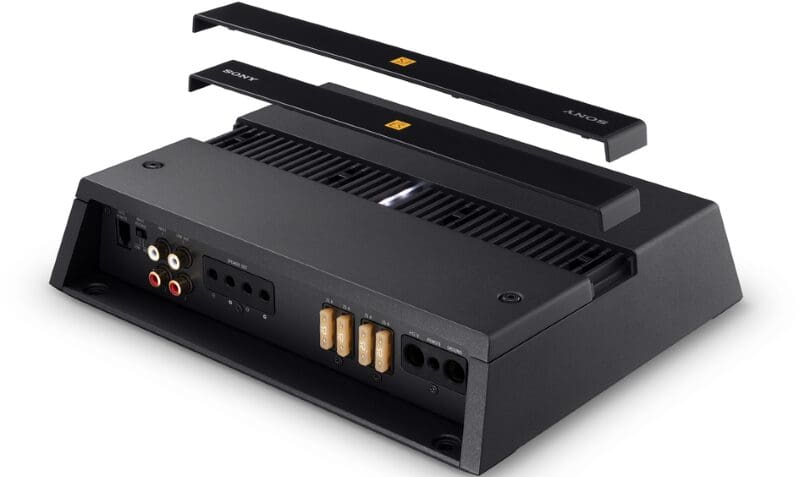
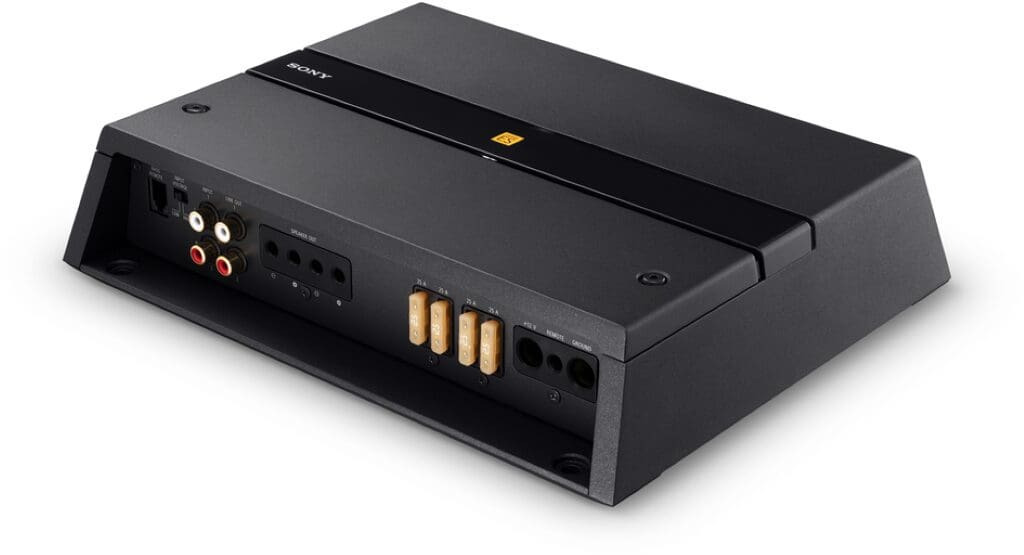
Circuit Board Features and Layout
As mentioned, the bottom cover is stamped from 1.2-mm aluminum with a heavily embossed reinforcing pattern. Sony noted that this change improved vibration performance by 50%. It sure beats 20-gauge steel or acrylic plastic! Inside the amp are a pair of modern, high-quality circuit boards populated with surface-mount devices wherever possible. All the electrolytic capacitors and the inductors are secured with silicone. The secondary board is mounted vertically and includes the signal processing switches and potentiometers. This is one of the few amplifiers I’ve seen with a metal shielding and reinforcing bracket for a daughterboard. Clearly, the designers at Sony considered reliability when developing this amplifier by not relying exclusively on pin-headers and solder connections to hold this board in place.
There’s a filter choke and six 4,700-microfarad, 16-volt capacitors on the input connections. The power supply output has six 4,700-microfarad, 50-volt caps for energy storage. The power supply uses eight Toshiba surface-mount N-Channel MOSFETS, each rated for 90 amps of continuous current handling. The outputs are also from Toshiba in the form of eight N-channel MOSFETS, each rated for 11 amps of current. That’s enough capacity for almost 4,000 watts of power. The outputs have a secondary stamped aluminum heatsink on top of them and are located near the cooling fan. Two large ferrite-enclosed chokes are used on the outputs to help ensure that the amplifier doesn’t emit radio-frequency noise during operation. The presence of two chokes and a check of the output signal indicates that this amp uses a bridge-tied load output design. Overall, the XM-1ES is well-designed and uses top-quality components and a thoughtful layout. It also has more energy storage than most amplifiers at this power level.
Auditioning the Sony Mobile ES XS-1ES Amplifier
I set the XM-1ES up in my lab and connected it to a Samlex SEC-100BRM power supply. Unlike switching supplies you’d find in a computer, this linear supply doesn’t have voltage drop issues when the amp suddenly draws a lot of current. In terms of audio, I fed the amp with a modified DRZ-9255 head unit, and it’s driving a 12-inch, 4-ohm, 500-watt audiophile-grade car audio subwoofer installed in a sealed enclosure. I’m using a set of home-audio bookshelf speakers with my reference amplifier to round out the system.
The first track I chose was “One” by Metallica. This track has been a popular choice for car audio reviewers as Lars Ulrich’s double kick drum is an excellent challenge for a subwoofer system. With the volume at what I’d consider insane levels, the XS-1ES had no problem defining each hammer hit on the bass drum skin with impressive clarity.
The next track was “Becoming Insane” by Infected Mushroom. These guys love their bass! The low-frequency energy pulses that flowed through the listening room were solid and well-controlled. There was no sense of sloppiness, even with the volume quite high.
My friends and I have seen Deadmau5 (aka Joel Zimmerman) a few times in one of his McLarens at the local Tim Horton’s over the years, so I thought I’d check out some of his music. I chose “Let Go” (feat. Grabbitz) from the uniquely named W:/2016Album/. I like mixes where the vocals are prominent and not buried behind a wall of sound. The track includes a deep bass line at 33 Hz and a harmonic at 66 Hz punctuated with occasional pulses down in the 27-Hz range. This track is a good choice if you want to punish your subwoofer system. This trance track sounded great in the listening room, thanks to the XM-1ES.
Bench Testing the Sony XM-1ES Subwoofer Amplifier
Satisfied with the sonic characteristics of the XM-1ES, it was time to take it next door to the lab and put it through its paces. Starting with frequency response measurements, the amp demonstrated massive bandwidth with -3 dB frequencies of 600 hertz on the top and below 2 hertz on the bottom. The low-pass and infrasonic filters work precisely as expected. Even with the infrasonic filter set to 5 hertz, the infrasonic performance of this amp outdoes many that cost significantly more.
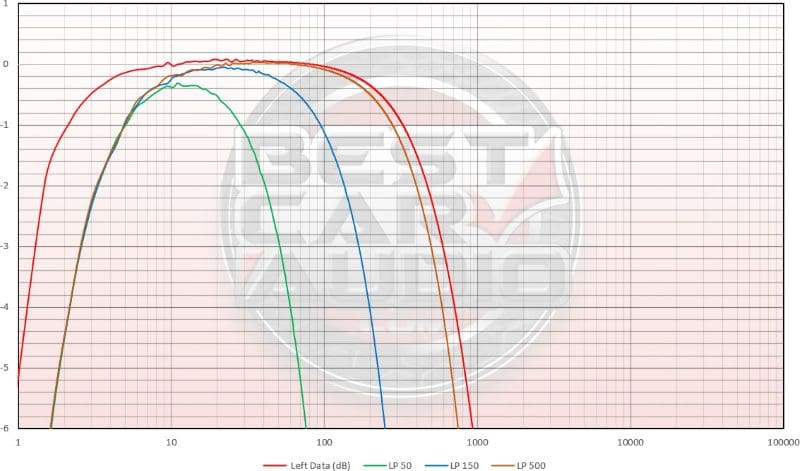
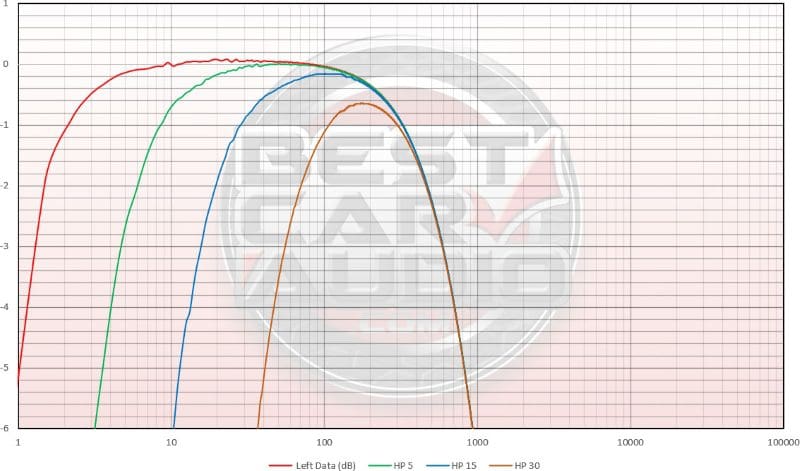
The next series of tests evaluate the harmonic distortion characteristics of the amp. I played a 50-Hz tone from my audio analyzer to observe the harmonic content characteristics at a 2-volt output level. The XM-1ES performed excellently with a THD+N measurement of 0.0192% and a signal-to-noise ratio of 75.62 dB. What does this mean? Tight, clear bass without muddiness and audible higher-frequency content in the output. It sounded great in the listening room, and the lab measurements correlate with those observations.
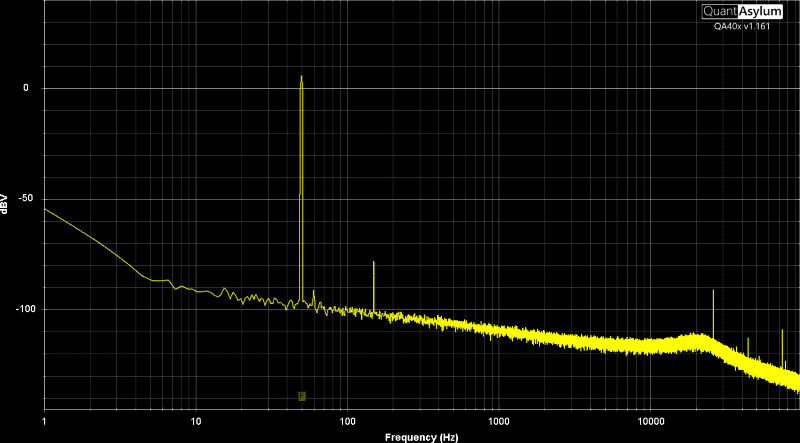
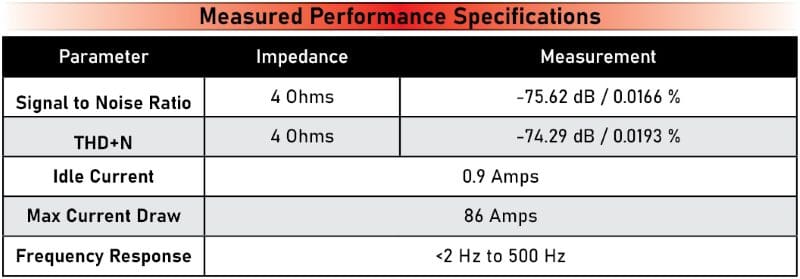
I followed this measurement by graphing the distortion and noise characteristics versus the amplifier’s output level to see how it behaved when pushed hard. Distortion remained below 0.07% right up until the amp went into clipping.
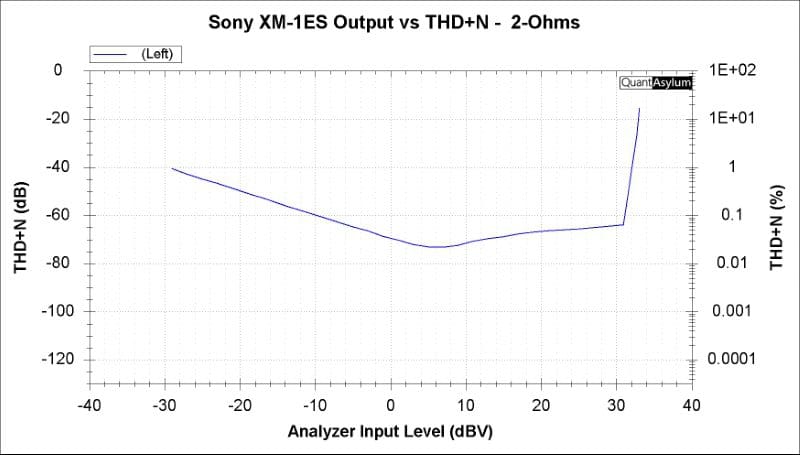
Last and certainly not least, it was time to test the amp for power production. I started with the amp wired to a 4-ohm load bank, then moved to 2-ohm testing. The amp was very clean and well-behaved on the bench, owing significantly to its bridge-tied load design. I noted that the maximum output power did not vary as it typically does with input supply voltage. This indicates that the power supply has fairly stiff regulation – something not common in today’s market. You can see from the chart below that the amplifier’s efficiency was very good at both 4- and 2-ohm loads. I’ve seen several amps that make similar power claims but only offer 50 to 55% efficiency. Those overheat quickly.
With the 1% THD+N numbers falling a little short of the published specifications, I decided to see what the amp would do when pushed such that it illuminated the Clipping indicator LED on my D’Amore Engineering AMM-1. With the light flickering, the amp produced 887 watts of power into a 2-ohm load when supplied with 13.88 volts at the power terminals and current consumption of 84.7 amps. For reference, this is an efficiency of 75%. With a full 14.4 volts, I have no doubt it would exceed its 1,000-watt rating.
Performance Summary of the Sony XS-1ES Amplifier
The first thing I want to say is that I am impressed that the amp doesn’t have a bass boost function. These are the bane of the industry, offering zero benefits in terms of realism or accuracy. If you want more bass, turn up all the bass – not just some of it. Second, the build quality of the XM-1ES is excellent. The custom cast-aluminum heatsink with its removable cover panel is clean and tidy and looks as though it belongs in a vehicle – a theme that Sony excels at. The features on the amp are top-notch, giving your installer everything they need to integrate it efficiently and reliably into your car or truck. Performance criteria on the XM-1ES are also impressive, with very low harmonic distortion and good efficiency.
If you’re shopping for a subwoofer amp that’s reliable and sounds great, then you owe it to yourself to visit a local Sony Mobile ES retailer and audition the XS-1ES and its companion 10- and 12-inch subwoofers. Be sure to follow Sony on Facebook to stay up-to-date with all their amazing car audio source unit, amplifier, speaker and subwoofer solutions.


